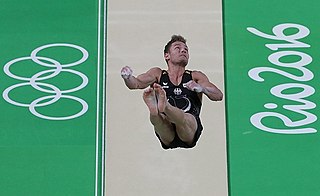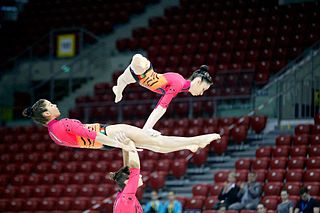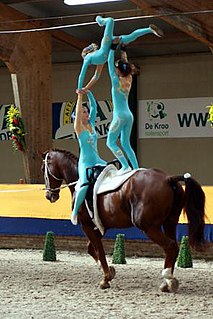 W
WGymnastics is a sport that includes physical exercises requiring balance, strength, flexibility, agility, coordination, and endurance. The movements involved in gymnastics contribute to the development of the arms, legs, shoulders, back, chest, and abdominal muscle groups. Gymnastics evolved from exercises used by the ancient Greeks that included skills for mounting and dismounting a horse, and from circus performance skills.
 W
WAcrobatic gymnastics is a competitive gymnastic discipline where partnerships of gymnasts work together and perform figures consisting of acrobatic moves, dance and tumbling, set to music. There are three types of routines; a 'balance' routine where the focus is on strength, poise and flexibility; a 'dynamic' routine which includes throws, somersaults and catches, and a 'combined' routine which includes elements from both balance and dynamic.
 W
WAerobic gymnastics or sport aerobics is a competitive sport originating from traditional aerobics in which complex, high-intensity movement patterns and elements of varying difficulty are performed to music.
 W
WCalisthenics or callisthenics is a form of strength training consisting of a variety of movements that exercise large muscle groups, such as standing, grasping, pushing, etc. These exercises are often performed rhythmically and with minimal equipment, as bodyweight exercises. They are intended to increase strength, fitness, and flexibility, through movements such as pulling, pushing, bending, jumping, or swinging, using one's body weight for resistance. Calisthenics can provide the benefits of muscular and aerobic conditioning, in addition to improving psychomotor skills such as balance, agility, and coordination.
 W
WDouble Mini Trampoline, sometimes referred to as Double Mini or DMT, is a Gymnastics discipline within Trampolining. Participants perform acrobatic skills on an apparatus smaller than a regular competition trampoline. The apparatus has both an angled section and a flat section. Unlike Individual Trampoline, where scoring is predominantly determined by Execution, Time of Flight and Difficulty, the Difficulty in DMT plays a more prominent role in the final score.
 W
WEquestrian vaulting, or simply vaulting, is most often described as gymnastics and dance on horseback, which can be practiced both competitively or non-competitively. Vaulting has a history as an equestrian act at circuses, but its origins stretch back at least two-thousand years. It is open to both men and women and is one of ten equestrian disciplines recognized by the International Federation for Equestrian Sports. Therapeutic or interactive vaulting is also used as an activity for children and adults who may have balance, attention, gross motor skill or social deficits.
 W
WFoot gymnastics are games and exercises intended to strengthen the muscles of legs and feet, improve the motion sequences of walking and sports, support therapy of varicose veins and dorsal pain. Such activities are recommended to improve flat feet especially of children and the gait performance of older adults.
 W
WGymnastic formation is a collective art based on gymnastics expressed by 30 to 5000 figurants using only human bodies without instruments. It is commonly presented in Japanese schools as a part of physical education curriculum. The expression of the collective beauty based on force, passion, and union of young men is much more important than the individual expression. It is a modality of mass game.
 W
WThe Gymnopaedia was an annual festival celebrated exclusively in ancient Sparta, helped to define Spartan identity. It featured generations of naked Spartan men participating in war dancing and choral singing, with a large emphasis placed on age and generational groups. It is believed that celebration of this festival began in 668 BCE to honour a Spartan victory in Thyrea. The festival likely evolved over time to celebrate other Spartan victories such as that over the Argives in the Battle of the Champions. The Gymnopaedia was primarily in honour of Apollo, but also celebrated Artemis and Leto, who served as representations of the childhood which would soon be left behind by the young participants. Though the festival was ritualistic, it should not necessarily be interpreted as religious. Pausanias describes the Gymnopaedia as "a festival which the Lacedaemonians take more seriously than any other".
 W
WHuman tower is a performance variation of gymnastic formation. Together with the human pyramid, it is exhibited frequently at the climax of the performance. In gymnastics, human tower is the highest and largest mounting. On the shoulder of the components of the base layer, put the feet of components of the second floor. In the same way, the components of higher floors are accumulated. The mounting is performed in sitting postulate. After the conclusion of the mounting, the tower stands up from lower floor to upper ones.
 W
WA majorette is a baton twirler whose twirling performance is often accompanied by dance, movement, or gymnastics; they are primarily associated with marching bands during parades. Majorettes can also spin knives, fire knives, flags, light-up batons, fire batons, maces and rifles. They do illusions, cartwheels, and flips, and sometimes twirl up to four batons at a time. Majorettes are often confused with cheerleaders; baton twirling, however, is more closely related to rhythmic gymnastics than to cheerleading.
 W
WMallakhamb is a traditional sport, originating from the Indian subcontinent, in which a gymnast performs aerial yoga or gymnastic postures and wrestling grips in concert with a vertical stationary or hanging wooden pole, cane, or rope. The word Mallakhamb also refers to the pole used in the sport. The pole is usually made from sheesham polished with castor oil. Three popular versions of Mallakhamb are practiced using a sheesham pole, cane, or rope.
 W
WA perfect 10 is a score of 10.000 for a single routine in artistic gymnastics, which was once thought to be unattainable—particularly at the Olympic Games—under the code of points set by the International Gymnastics Federation (FIG). It is generally recognized that the first person to score a perfect 10 at the Olympic Games was Romanian Nadia Comăneci, at the 1976 Games in Montreal. Other women who accomplished this feat at the Olympics include Nellie Kim, also in 1976, Mary Lou Retton in 1984, Daniela Silivaș and Yelena Shushunova in 1988, and Lavinia Miloșovici in 1992. The first man to score a perfect 10 is considered to be Alexander Dityatin, at the 1980 Olympics in Moscow.
 W
WPole climbing is ascending a pole which one can grip with his or her hands. The related activity of mast climbing describes ascending an object similar to a pole, but having a larger diameter which excludes gripping with the hands. In either case, it is normally assumed that climbers who view the activity as a gymnastic sport use only their bodies and limbs, without artificial aids.
 W
WPole dance combines dance and acrobatics centered on a vertical pole. This performance art form takes place not only in gentleman's clubs as erotic dance, but also as a mainstream form of fitness, practiced in gyms and dedicated dance studios. Pole dancing enthusiasts are of all ages; although many who perform this dance and acrobatic form are adults, that does not stop younger children from learning and performing in competitions. Amateur and professional pole dancing competitions are held in countries around the world.
 W
WRhythmic gymnastics is a sport in which gymnasts perform on a floor with an apparatus: hoop, ball, clubs, ribbon or rope. The sport combines elements of gymnastics, dance and calisthenics; gymnasts must be strong, flexible, agile, dexterous and coordinated. Rhythmic gymnastics is governed by the International Gymnastics Federation (FIG), which first recognized it as a sport in 1963. It became an Olympic sport in 1984, with an individual all-around event. The group all-around competition was added to the Olympics in 1996. At the international level, rhythmic gymnastics is a women-only sport. The most prestigious competitions, besides the Olympic Games, are the World Championships, World Games, European Championships, European Games, the World Cup Series and the Grand Prix Series. Gymnasts are judged on their artistry, execution of skills, and difficulty of skills, for which they gain points. They perform leaps, balances and rotations along with handling the apparatus.
 W
WAcrobatic Rock'n'Roll is a very athletic, competitive form of partner dance that originated from lindy hop. Unlike lindy hop, however, it is a choreographed dance designed for performance. It is danced by both couples and groups, either all-female or four to eight couples together. This is normally a very fast and physically demanding dance.
 W
WRope climbing is a sport in which competitors attempt to climb up a suspended vertical rope using only their hands. Rope climbing is practiced regularly at the World Police and Fire Games, and is enjoying a resurgence in France, where competitions are held in shopping centers. Also, enthusiasts in the Czech Republic resurrected the sport in 1993, and hold local and national competitions.
 W
WTrampolining or trampoline gymnastics is a recreational activity, acrobatic training tool as well as a competitive Olympic sport in which athletes perform acrobatics while bouncing on a trampoline. In competition, these can include simple jumps in the straight, pike, tuck, or straddle position to more complex combinations of forward and/or backward somersaults and twists. Scoring is based on the difficulty and on the total seconds spent in the air. Points are deducted for bad form and horizontal displacement from the center of the bed.
 W
WTricking is a training discipline that combines kicks with flips and twists from martial arts and gymnastics as well as many dance moves and styles from breakdancing. It aims to achieve an aesthetic display of different combinations of "tricks". Tricking practitioners are commonly referred to as trickers. Examples of tricking techniques include the 540 kick, the corkscrew (cork), the flashkick, the butterfly twist and the double leg.
 W
WTumbling, sometimes referred to as power tumbling, is a gymnastics discipline in which participants perform a series of acrobatic skills down a 25 metres (82 ft) long sprung track. Each series, known as a pass, comprises eight elements in which the athlete jumps, twists and flips placing only their hands and feet on the track. Tumblers are judged on the difficulty and form of their routine. There are both individual and team competitions in the sport.
 W
WIn dance and gymnastics, a turn is a rotation of the body about the vertical axis. It is usually a complete rotation of the body, although quarter (90°) and half (180°) turns are possible for some types of turns. Multiple, consecutive turns are typically named according to the number of 360° rotations.
 W
WWheel gymnastics is a form of gymnastics that originated in Germany. Wheel gymnasts do exercises in a large wheel or hoop known as the Rhönrad, gymnastics wheel, gym wheel, or German wheel, in the beginning also known as ayro wheel, aero wheel, and Rhon rod.